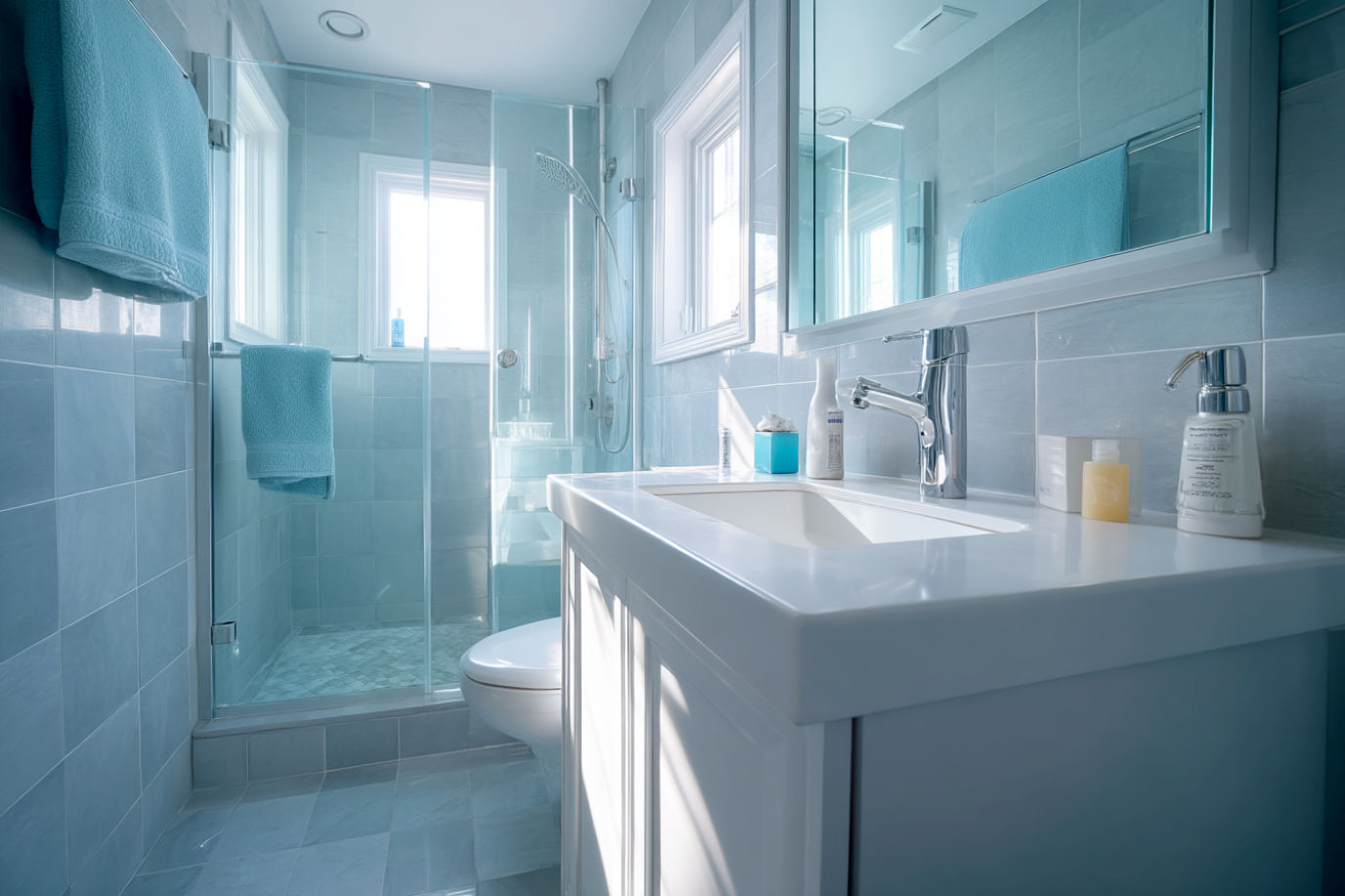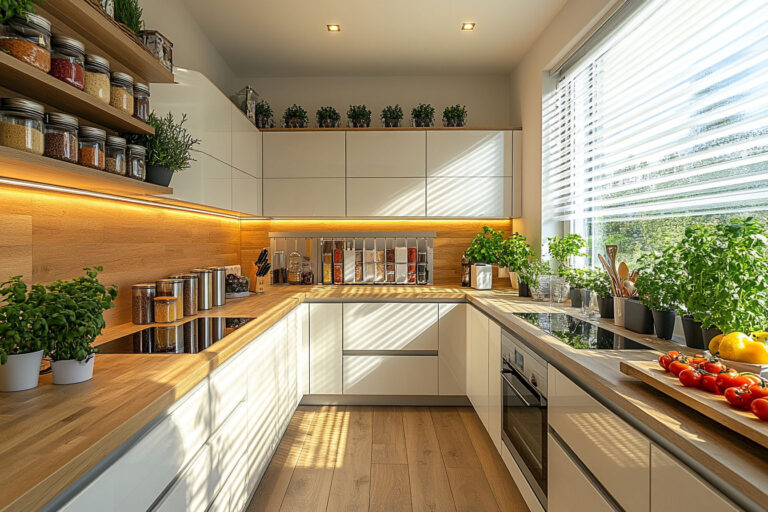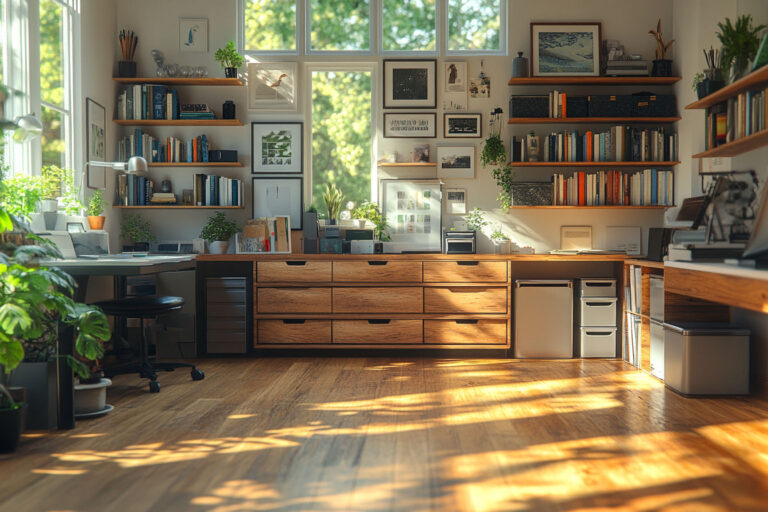This post may contain affiliate links. If you make a purchase through these links, we may earn a commission at no additional cost to you.
Creating an outdoor living space doesn’t have to drain your savings or take weeks to complete. With some planning and the right approach, you can build a budget-friendly patio in one weekend while keeping costs low. A DIY patio project not only saves money on professional labor but gives you the satisfaction of creating something with your own hands.
The average professionally installed budget patio costs between $2,000 and $5,000, but by doing it yourself, you can cut that price by 50-70%. That means more money in your pocket for patio furniture, plants, or other home projects. The key is choosing the right materials, having a solid plan, and working efficiently.
PROJECT SCOPE & EXPECTATIONS
This DIY plan is designed for:
- A basic 100-200 square foot patio (10’x10′ to 12’x16′)
- Ground-level installation (no raised designs)
- Simple square or rectangular shapes
- Basic materials (pavers, gravel, or stepping stones)
- Budget range: $300-$1,200 total
This DIY plan is NOT suitable for:
- Patios larger than 200 square feet
- Sloped terrain requiring retaining walls
- Complex designs with curves or multiple levels
- Projects requiring drainage systems
- Installations on unstable soil conditions
This guide breaks down the entire process into manageable steps that even first-time DIYers can follow. You’ll learn how to select an ideal location, choose affordable materials that don’t sacrifice quality, gather the necessary tools, and follow a time-efficient construction process. By Monday morning, you’ll be enjoying coffee on your new patio, amazed at what you accomplished in just two days.
Whether you’re looking to create a simple grilling area, a cozy reading nook, or an entertainment space for friends and family, this budget-friendly weekend project will transform your outdoor area without breaking the bank. Let’s get started on planning your perfect patio.
1: Planning Your Budget-Friendly Patio
The foundation of a successful weekend patio project starts with smart planning. Taking time to think through your design now will save you both money and headaches later.
First, scout your yard for the ideal patio location. Look for level areas to minimize digging and consider natural features like trees for shade or views you want to highlight. Most homeowners place patios close to a back door for easy access from the kitchen. Measure your desired space and mark the corners with stakes and string to visualize the size. For a weekend project, keep it manageable—most budget-friendly DIY patios range between 100-200 square feet.
Setting a realistic budget is crucial. Plan to spend $3-10 per square foot, depending on your material choices. For a 12×12-foot patio, budget $500-1,200 for materials. Always add a 15% buffer for unexpected costs. Gravel is your cheapest option at $1-2 per square foot, while concrete pavers run $2-5, and flagstone costs $5-10. Remember to include costs for base materials like crushed stone and sand.
Design with your budget in mind. Simple square or rectangular designs require less cutting and wasted materials. For visual interest without added costs, consider patterns with the same materials rather than mixing expensive options.
Create a realistic timeline for your weekend. Saturday morning should focus on preparation and base work. By Sunday afternoon, aim to complete the laying of materials and basic cleanup. Schedule material delivery for Friday to avoid delays.
Finally, check local building codes before starting. Many municipalities don’t require permits for ground-level patios under 200 square feet, but some have regulations about distance from property lines or drainage requirements. A quick call to your local building department can prevent costly corrections later.
2: Selecting Affordable Materials
Finding budget-friendly materials is the key to keeping your patio project affordable without sacrificing quality. The right choices can save you hundreds of dollars while still creating a beautiful outdoor space.
Concrete pavers offer the best balance of cost, durability, and ease of installation for weekend warriors. Basic pavers cost $1.50-$3 per square foot at home improvement stores, and they come in various colors and shapes. For even better deals, check for end-of-season sales or visit stone yards that sell overstock or slightly imperfect pavers at 30-50% discounts.
Gravel provides an even more economical option at $0.75-$1.50 per square foot. Pea gravel creates a casual, cottage-garden feel, while decomposed granite offers a more compacted surface. Both require proper edging to keep them contained but can be installed quicker than pavers.
For truly budget-conscious DIYers, consider repurposed materials. Broken concrete (sometimes called “urbanite”) from demolition sites is often free if you haul it yourself. Arranged properly, these pieces create a charming, flagstone-like patio at a fraction of the cost.
Don’t forget the foundation materials. You’ll need approximately 4 inches of compactable gravel base (about $0.50 per square foot) and 1 inch of sand ($0.25 per square foot). Calculate your quantities carefully—buying too much wastes money, while too little causes project delays.
For material delivery, compare prices between big box stores and local suppliers. While home improvement chains offer convenience, local landscape supply companies often provide better rates on bulk materials. If you have a pickup truck, save the delivery fee ($50-100) by transporting smaller quantities yourself. For larger orders, schedule delivery for Friday afternoon so you’re ready to start early Saturday.
3: Essential Tools and Equipment
The right tools make your patio project faster and easier without breaking your budget. Many weekend warriors overspend on equipment they’ll rarely use again, but smart choices help you save.
For basic site preparation, you’ll need a shovel, rake, wheelbarrow, and tape measure. A long level and string line are essential for ensuring your patio has proper slope for drainage (aim for a 1-inch drop every 4 feet away from your house). Most homeowners already own these basic tools, so check your garage before buying.
Specialized tools like a tamper for compacting the base are necessary but expensive to purchase for one-time use. Rent one from a home improvement store for about $20-30 per day instead of spending $100+ to buy. The same goes for a masonry saw if you need to cut pavers—a weekend rental costs about $50 compared to $300+ for purchase.
Borrow tools when possible. Ask neighbors, friends, or family members if they have wheelbarrows, levels, or other equipment you can use for the weekend. Many neighborhoods have tool-sharing groups on social media where you can find what you need for free.
Don’t skimp on safety equipment. Work gloves ($5-10), knee pads ($15-20), and safety glasses ($5) protect you from injury and are worth every penny. Back braces ($20-25) can prevent strain when lifting heavy materials.
For beginners without specialized tools, look for creative alternatives. A 2×4 board can work as a screed to level sand. A rubber mallet ($10) is cheaper than a specialized rubber paver hammer ($30). For edge restraints, consider using pressure-treated lumber instead of commercial edging if you’re on a tight budget.
4: Step-by-Step Weekend Construction Process
Transforming your yard into a patio in just one weekend requires an organized approach and efficient use of time. This schedule breaks the process into manageable chunks so you’ll finish by Sunday evening.
Start Saturday morning by removing grass and topsoil from your marked area. Dig down 6-8 inches, depending on your climate (colder regions need deeper bases). Save time by renting a sod cutter ($70/day) rather than digging by hand. By noon, you should have a clean, excavated area with straight edges. Check your depth with stakes and string to ensure consistency.
Saturday afternoon focuses on building your base. Spread 4 inches of crushed stone or gravel in 2-inch layers, compacting each layer thoroughly with your tamper. This step is crucial—a properly compacted base prevents future settling and shifting. Water the gravel lightly before tamping for better compaction. Aim to finish the base by Saturday evening.
Sunday morning, install edge restraints around the perimeter. Plastic or metal edging ($1-2 per foot) holds everything in place. Next, add a 1-inch layer of sand, leveling it with a screed board (a straight 2×4) pulled across the surface. Take your time ensuring the sand is level but maintains the slight drainage slope away from your house.
Sunday afternoon is for laying your pavers or material. Work from one corner, setting each paver in place with a slight tap from a rubber mallet. Use the string lines to keep rows straight. For the finishing touch, spread polymeric sand between pavers and mist with water to lock everything in place. By Sunday evening, sweep off excess sand and admire your new patio.
Time-saving tip: Have all family members help during the installation. One person can place pavers while another brings materials and a third cuts pieces for edges. Working as a team can cut hours off your project time.
5: Budget-Friendly Finishing Touches
After completing your patio’s construction, the right finishing touches transform it from a simple surface into an inviting outdoor living space—without emptying your wallet. These affordable additions create ambiance and functionality without requiring another weekend of work.
Furniture doesn’t need to be expensive to be stylish. Check thrift stores, yard sales, or Facebook Marketplace for secondhand patio sets, often available for 70-80% off retail prices. A simple coat of spray paint ($5-10 per can) refreshes tired furniture instantly. Alternatively, repurpose indoor furniture you’re planning to replace, treating wood items with exterior sealant for weather protection.
Lighting creates evening magic for just a few dollars. Solar path lights cost as little as $2-3 each and require no wiring. String lights hung overhead ($15-25 per strand) create a festive atmosphere. For a truly budget option, place tea lights in mason jars for charming, wind-protected illumination that costs pennies per evening.
Plants soften the patio’s edges and add natural beauty. Start with just a few larger containers rather than many small ones for greater visual impact. Choose perennials instead of annuals for multiyear enjoyment without replanting. Native plants typically require less water and maintenance, saving money long-term. Many garden centers offer end-of-season plant sales with discounts up to 75%.
DIY accessories personalize your space affordably. Make your own outdoor pillows using fabric remnants and stuffing from old bed pillows. Create a simple fire pit by arranging pavers in a circle atop your patio (where permitted by local codes). Repurpose containers like galvanized tubs or wooden crates as side tables or planters.
Protect your new investment with basic maintenance. Apply paver sealer ($30 for DIY application) every two years to prevent staining and extend your patio’s life. Keep a bag of extra sand for touching up joints as needed, and remove weeds promptly before they become established.
WEEKEND PATIO PROJECT CHECKLIST
PLANNING
- [ ] Measure and mark patio area with stakes and string
- [ ] Check local building codes and regulations
- [ ] Create a simple sketch with dimensions
- [ ] Calculate material quantities needed
- [ ] Set budget with 15% contingency
- [ ] Schedule material delivery for Friday
MATERIALS
- [ ] Base materials:
- [ ] Crushed stone/gravel (4″ depth)
- [ ] Paver sand (1″ depth)
- [ ] Surface materials:
- [ ] Pavers, gravel, or alternative material
- [ ] Edge restraints/edging
- [ ] Polymeric sand for joints
- [ ] Optional extras:
- [ ] Landscape fabric for weed prevention
- [ ] Paver sealer
TOOLS
- [ ] Measuring tape
- [ ] Shovel and rake
- [ ] Wheelbarrow
- [ ] Level (4′ or longer)
- [ ] String line and stakes
- [ ] Tamper (rent)
- [ ] Rubber mallet
- [ ] Work gloves
- [ ] Knee pads
- [ ] Safety glasses
- [ ] 2×4 board for screeding sand
- [ ] Push broom
- [ ] Garden hose with spray nozzle
- [ ] Optional: Masonry saw for cutting pavers (rent)
SATURDAY SCHEDULE
- [ ] Morning:
- [ ] Remove grass/topsoil from marked area
- [ ] Dig down 6-8 inches
- [ ] Check depth consistency
- [ ] Ensure proper slope (1″ drop per 4′)
- [ ] Afternoon:
- [ ] Lay landscape fabric (if using)
- [ ] Add crushed stone/gravel in 2″ layers
- [ ] Compact each layer thoroughly
- [ ] Check level and slope
SUNDAY SCHEDULE
- [ ] Morning:
- [ ] Install edge restraints
- [ ] Spread 1″ layer of paver sand
- [ ] Level sand with screed board
- [ ] Recheck slope for drainage
- [ ] Afternoon:
- [ ] Lay pavers or surface material
- [ ] Cut edge pieces as needed
- [ ] Spread polymeric sand between joints
- [ ] Mist with water to set sand
- [ ] Clean surface
- [ ] Optional: Apply sealer
FINISHING TOUCHES
- [ ] Basic furniture arrangement
- [ ] Simple lighting installation
- [ ] Container plants
- [ ] Take “after” photos!
⚠️ TROUBLESHOOTING TIPS: WHEN THINGS DON’T GO AS PLANNED
| PROBLEM | QUICK FIX |
|---|---|
| 🌧️ Rain interrupts your project | Cover excavated area with plastic tarps. For partially completed work, ensure proper drainage away from your house. If base materials get saturated, allow an extra day to dry before continuing. |
| 🪨 Hit large rocks during digging | Small rocks can be removed by hand. For large buried rocks, work around them by digging slightly deeper elsewhere, or use them as a stable base element. For massive rocks, consider adjusting your patio shape. |
| 📏 Pavers don’t fit perfectly at edges | Don’t stretch joints! Instead, cut pavers with a masonry saw (rent one) or consider changing the pattern. For odd corners, try using smaller pavers to fill gaps. |
| 〰️ Base isn’t perfectly level | Don’t panic about minor variations. Use extra sand to compensate for small dips before laying pavers. For serious low spots (more than 1/2″), remove pavers, add more base material, and compact again. |
| 🧩 Running out of materials | Always calculate an extra 10-15% for waste. If you run short, focus on completing the main visible areas first, and make a quick supply run for edge areas. Many stores are open both Saturday and Sunday. |
| 🌿 Tree roots in excavation area | Small roots (under 1/2″) can be cut. For larger roots, avoid cutting (which can harm the tree) and work around them by adjusting depth or patio shape. |
| 🏠 Drainage issues appear | Ensure your patio slopes away from your house (1″ per 4′). If puddling occurs elsewhere, consider installing a small French drain alongside problem areas after your initial build. |
TIP: Take photos of any unusual situations you encounter and bring them to your local home improvement store. Many employees have tackled similar projects and can offer specific advice for your scenario.
💰 DIY VS. PROFESSIONAL INSTALLATION: THE REAL COST BREAKDOWN
Small Patio (100 sq. ft / 10′ x 10′)
| EXPENSE CATEGORY | DIY COST | PROFESSIONAL COST | YOUR SAVINGS |
|---|---|---|---|
| Materials | $300 – $500 | $300 – $500 | $0 |
| Labor | $0 (YOUR TIME) | $800 – $1,500 | $800 – $1,500 |
| Equipment | $50 – $100 (RENTALS) | Included in labor | -$50 to -$100 |
| Design | $0 (YOUR CREATIVITY) | $200 – $500 | $200 – $500 |
| TOTAL | $350 – $600 | $1,300 – $2,500 | $950 – $1,900 |
Medium Patio (200 sq. ft / 10′ x 20′)
| EXPENSE CATEGORY | DIY COST | PROFESSIONAL COST | YOUR SAVINGS |
|---|---|---|---|
| Materials | $600 – $1,000 | $600 – $1,000 | $0 |
| Labor | $0 (YOUR TIME) | $1,600 – $3,000 | $1,600 – $3,000 |
| Equipment | $75 – $150 (RENTALS) | Included in labor | -$75 to -$150 |
| Design | $0 (YOUR CREATIVITY) | $300 – $700 | $300 – $700 |
| TOTAL | $675 – $1,150 | $2,500 – $4,700 | $1,825 – $3,550 |
TIME INVESTMENT COMPARISON:
- DIY: 1 weekend (16-20 hours) + planning time
- Professional: 1-3 hours of your time for consultation + 2-4 days of work done by others
THE BOTTOM LINE: For a typical 200 sq. ft patio, DIY saves you approximately $2,700 on average. That’s around $135-$170 per hour for your labor – likely much more than your day job pays!
🌤️ BEST SEASONS FOR YOUR PATIO PROJECT
SPRING 🌱
PROS:- Moderate temperatures for physical work
- Softer ground for easier digging
- Sales on outdoor materials starting
- Complete in time for summer enjoyment
- Spring rains can delay project
- Materials may be at peak pricing
SUMMER ☀️
PROS:- Dry conditions ensure stable base
- Extended daylight hours
- Immediate use after completion
- Heat can make work uncomfortable
- Harder, drier soil is more difficult to dig
- Peak pricing season for materials
FALL 🍂
PROS:- Cooler working temperatures
- End-of-season discounts on materials
- Ground still workable before frost
- Less competition for rental equipment
- Limited immediate enjoyment before winter
- Falling leaves can interfere with work
WINTER ❄️
PROS:- Rock-bottom prices on materials
- Advance planning time
- Frozen ground makes digging impossible
- Cold temperatures affect material setting
- Limited daylight hours
🌎 REGIONAL CONSIDERATIONS
COLD CLIMATE REGIONS
- Dig base 8-12″ deep (not the standard 6-8″) to account for frost heave
- Consider adding a layer of geotextile fabric under the base material
- Schedule projects for late spring through early fall
- Use polymeric sand that can withstand freeze-thaw cycles
HOT CLIMATE REGIONS
- Install during cooler morning hours
- Use light-colored pavers to reduce heat absorption
- Consider slightly wider gaps between pavers for thermal expansion
- Ensure proper drainage for sudden heavy rain in desert climates
HUMID REGIONS
- Allow extra drying time between stages
- Consider adding extra drainage if soil doesn’t percolate well
- Use mold-resistant polymeric sand if available
- Apply sealer once fully dry to prevent moisture issues
🌱 ECO-FRIENDLY PATIO ALTERNATIVES
WHY GO GREEN WITH YOUR PATIO?
Building with environmental consciousness doesn’t mean sacrificing your budget or weekend timeline. Eco-friendly patio options offer benefits beyond sustainability:
SUSTAINABLE MATERIAL OPTIONS
| Material | Eco-Benefits | Cost Impact | DIY Difficulty |
|---|---|---|---|
| Permeable Pavers | Allow water to filter through to groundwater | +10-20% over standard pavers | ★★★☆☆ |
| Recycled Material Pavers | Made from plastic, rubber, or glass waste | -5% to +15% vs. standard | ★★☆☆☆ |
| Decomposed Granite | Natural material with good permeability | -30% vs. standard pavers | ★★☆☆☆ |
| Reclaimed Brick/Stone | Repurposes existing materials | -50% to FREE (if self-sourced) | ★★★☆☆ |
| “Grass Pavers” Grid | Plastic/concrete grid with grass growing through | -10% vs. standard pavers | ★★★★☆ |
| Spaced Natural Flagstone | Includes planting spaces between stones | +0% (uses less stone, more plants) | ★★★☆☆ |
ECO-FRIENDLY WEEKEND PATIO SPOTLIGHT: PERMEABLE PAVER SYSTEM
For environmentally conscious homeowners who still want to complete a patio in one weekend, permeable pavers offer the best balance of sustainability and practicality.
Weekend-Compatible Process:
- Follow the same excavation process (dig 2″ deeper than standard)
- Use clean, angular gravel (3/4″) instead of crusher run for the base
- Skip the landscape fabric (permeable systems need water flow)
- Use coarse-grained sand instead of regular paver sand
- Install pavers with wider joints (1/4″-3/8″)
- Fill joints with small, clean gravel instead of polymeric sand
Materials Needed:
- Permeable pavers (try brands like Belgard, Unilock, or Pavestone)
- 6″ of 3/4″ clean, angular gravel
- Coarse-grained sand (ASTM C33)
- 1/8″ clear crushed stone for joints
Cost Difference: Approximately $50-75 more for a 100 sq. ft. patio compared to standard materials
Conclusion
Building your own budget-friendly patio in one weekend delivers multiple rewards beyond just the money you’ve saved. You now have a beautiful outdoor space that would have cost at least twice as much if professionally installed, plus the satisfaction of creating something lasting with your own hands.
The value extends far beyond the immediate project completion. Your new patio increases your home’s usable living space and potentially its resale value, all while providing years of enjoyment for family gatherings, quiet mornings with coffee, or evening relaxation under the stars. The skills you’ve gained during this weekend project will serve you in future home improvement endeavors.
Don’t be surprised if neighbors ask who installed your patio—and feel free to proudly tell them you did it yourself in just one weekend. Consider documenting your process with before, during, and after photos to share your success. Your project might inspire friends to tackle their own outdoor transformations.
Remember that your patio can evolve over time. As budget allows, you can add more elaborate features like pergolas, built-in benches, or outdoor kitchens. The solid foundation you’ve created this weekend will support these future enhancements, making your initial investment even more valuable.
Now it’s time to enjoy the fruits of your labor. Bring out some refreshments, invite friends over, and celebrate your accomplishment on your new budget-friendly patio. You’ve turned a weekend of work into years of outdoor enjoyment.




